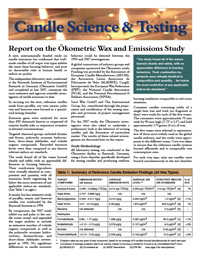Introduction
For those interested in the whole field of candles, their history, care and other aspects, the following pages make fascinating reading.
How a candle burns
The heat of the match used to light the candle melts and evaporates a small amount of fuel. Once vaporized, the fuel combines with oxygen in the atmosphere to form a flame. This flame provides sufficient heat to keep the candle burning via a self-sustaining chain of events: the heat of the flame melts the top of the mass of solid fuel, the liquefied fuel then moves upward through the wick via capillary action, and the liquefied fuel is then vaporized to burn within the candle's flame.
The burning of the fuel takes place in several distinct regions (as evidenced by the various colors that can be seen within the candle's flame). Within the bluer regions (600 deg C), hydrogen is being separated from the fuel and burned to form water vapour. The brighter, yellower part of the flame (1200-1400 deg C) is the remaining carbon being oxidized to form carbon dioxide.
As the mass of solid fuel is melted and consumed, the candle grows shorter. Portions of the wick that are not evaporating the liquid fuel are consumed in the flame, limiting the exposed length of the wick and keeping the temperature and rate of fuel consumption even. Some wicks require manual trimming with scissors or a wick trimmer for even burning.
Candle Science
Click the magazine page below to download a 4-page scientific report about a detailed emissions study of different waxes. It will set some current eco-trend myths straight.
With special thanks to the publishers, © 2008.


